The Impact of Soil Hydrothermal Properties on Geothermal Power Generation (GPG): Modeling and Analysis
Abstract
:1. Introduction
2. Numerical Geo-Model
2.1. Groundwater Flow
2.2. Underground Heat Transfer
3. Electrical Analysis
4. Results and Discussion
4.1. Distribution of Pressure and Temperature
4.2. Well Distance
4.3. Electrical Impact
5. Conclusions
- (1)
- Models for underground systems with different geological and thermal properties were established, which can be used to effectively reduce exploration risks.
- (2)
- The heat storage conditions of the geological structure after 10 years of operation based on the constructed geological model were analyzed. The outlet temperature dropped at a rate of 2 K per year within 10 years, which can be used to evaluate the production cycle and investment return of the power plant in the future.
- (3)
- With a change in well distance, the outlet temperature also changes. However, when the distance exceeds 200 m, the change is no longer obvious. This result is of great significance for the construction of geothermal power plants under different conditions.
- (4)
- The ideal power output by the heat source gradually decreases. The rate of attenuation becomes faster after the fifth year, and efficiency is lower than 9.75%. However, more geothermal power plants are considering the use of carbon dioxide to replace the original water as a working fluid. This may be a novel direction for future scholars.
Author Contributions
Funding
Institutional Review Board Statement
Informed Consent Statement
Data Availability Statement
Conflicts of Interest
References
- Hou, G.; Taherian, H. Performance analysis of a hybrid ground source heat pump system integrated with liquid dry cooler. Appl. Therm. Eng. 2019, 159, 113830. [Google Scholar] [CrossRef]
- Hou, G.; Taherian, H.; Li, L. A predictive TRNSYS model for long-term operation of a hybrid ground source heat pump system with innovative horizontal buried pipe type. Renew. Energy 2019, 151, 1046–1054. [Google Scholar] [CrossRef]
- Xia, L.; Zhang, Y. An overview of world geothermal power generation and a case study on China—The resource and market perspective. Renew. Sustain. Energy Rev. 2019, 112, 411–423. [Google Scholar] [CrossRef]
- Moya, D.; Aldás, C.; Kaparaju, P. Geothermal energy: Power plant technology and direct heat applications. Renew. Sustain. Energy Rev. 2018, 94, 889–901. [Google Scholar] [CrossRef]
- Clauser, C.; Ewert, M. The renewables cost challenge: Levelized cost of geothermal electric energy compared to other sources of primary energy – Review and case study. Renew. Sustain. Energy Rev. 2018, 82, 3683–3693. [Google Scholar] [CrossRef]
- Cui, Y.; Zhu, J.; Twaha, S.; Riffat, S. A comprehensive review on 2D and 3D models of vertical ground heat exchangers. Renew. Sustain. Energy Rev. 2018, 94, 84–114. [Google Scholar] [CrossRef]
- Mauro, A.; Grossman, J.C. Street-heat: Controlling road temperature via low enthalpy geothermal energy. Appl. Therm. Eng. 2017, 110, 1653–1658. [Google Scholar] [CrossRef]
- Li, Q.; Yin, Y.; Kong, L.; Qiao, L. Enhancing heat transfer in the heat exchange medium of energy piles. J. Build. Eng. 2021, 40, 102375. [Google Scholar] [CrossRef]
- Clarke, J.; McLeskey, J.T. Multi-objective particle swarm optimization of binary geothermal power plants. Appl. Energy 2015, 138, 302–314. [Google Scholar] [CrossRef]
- Wang, Y.; Du, Y.; Wang, J.; Zhao, J.; Deng, S.; Yin, H. Comparative life cycle assessment of geothermal power generation systems in China. Resour. Conserv. Recycl. 2020, 155, 104670. [Google Scholar] [CrossRef]
- Yildirim, N.; Parmanto, S.; Akkurt, G.G. Thermodynamic assessment of downhole heat exchangers for geothermal power generation. Renew. Energy 2019, 141, 1080–1091. [Google Scholar] [CrossRef]
- Wei, G.; Meng, J.; Du, X.; Yang, Y. Performance Analysis on a Hot Dry Rock Geothermal Resource Power Generation System Based on Kalina Cycle. Energy Procedia 2015, 75, 937–945. [Google Scholar] [CrossRef] [Green Version]
- Alimonti, C.; Soldo, E.; Bocchetti, D.; Berardi, D. The wellbore heat exchangers: A technical review. Renew. Energy 2018, 123, 353–381. [Google Scholar] [CrossRef]
- Zhu, J.; Hu, K.; Lu, X.; Huang, X.; Liu, K.; Wu, X. A review of geothermal energy resources, development, and applications in China: Current status and prospects. Energy 2015, 93, 466–483. [Google Scholar] [CrossRef]
- Von Jouanne, A.; Brekken, T.K. Ocean and Geothermal Energy Systems. Proc. IEEE 2017, 105, 2147–2165. [Google Scholar] [CrossRef]
- Tomasini-Montenegro, C.; Santoyo-Castelazo, E.; Gujba, H.; Romero, R.J.; Santoyo, E. Life cycle assessment of geothermal power generation technologies: An updated review. Appl. Therm. Eng. 2017, 114, 1119–1136. [Google Scholar] [CrossRef]
- Wang, J.; Wang, J.; Dai, Y.; Zhao, P. Thermodynamic analysis and optimization of a flash-binary geothermal power generation system. Geothermics 2015, 55, 69–77. [Google Scholar] [CrossRef]
- Çetin, G.; Özkaraca, O.; Keçebaş, A. Development of PID based control strategy in maximum exergy efficiency of a geothermal power plant. Renew. Sustain. Energy Rev. 2020, 137, 110623. [Google Scholar] [CrossRef]
- Tasnin, W.; Saikia, L.C.; Raju, M. Deregulated AGC of multi-area system incorporating dish-Stirling solar thermal and geothermal power plants using fractional order cascade controller. Int. J. Electr. Power Energy Syst. 2018, 101, 60–74. [Google Scholar] [CrossRef]
- Ghaebi, H.; Farhang, B.; Parikhani, T.; Rostamzadeh, H. Energy, exergy and exergoeconomic analysis of a cogeneration system for power and hydrogen production purpose based on TRR method and using low grade geothermal source. Geothermics 2018, 71, 132–145. [Google Scholar] [CrossRef]
- Kanoglu, M.; Dincer, I. Performance assessment of cogeneration plants. Energy Convers. Manag. 2009, 50, 76–81. [Google Scholar] [CrossRef]
- Hou, G.; Taherian, H.; Li, L.; Fuse, J.; Moradi, L. System performance analysis of a hybrid ground source heat pump with optimal control strategies based on numerical simulations. Geothermics 2020, 86, 101849. [Google Scholar] [CrossRef]
- Cook, D.; Davidsdottir, B.; Petursson, J.G. Accounting for the utilisation of geothermal energy resources within the genuine progress indicator—A methodological review. Renew. Sustain. Energy Rev. 2015, 49, 211–220. [Google Scholar] [CrossRef]
- Carey, J.W.; Lei, Z.; Rougier, E.; Mori, H.; Viswanathan, H. Fracture-permeability behavior of shale. J. Unconv. Oil Gas Resour. 2015, 11, 27–43. [Google Scholar] [CrossRef]
- Mourzenko, V.V.; Thovert, J.-F.; Adler, P.M. Conductivity and Transmissivity of a Single Fracture. Transp. Porous Media 2018, 123, 235–256. [Google Scholar] [CrossRef]
- Zhou, J.; Chen, Y.; Wang, L.; Cardenas, M.B. Universal Relationship Between Viscous and Inertial Permeability of Geologic Porous Media. Geophys. Res. Lett. 2019, 46, 1441–1448. [Google Scholar] [CrossRef]
- Chang, A.; Sun, H.; Zhang, Y.; Zheng, C.; Min, F. Spatial fractional Darcy’s law to quantify fluid flow in natural reservoirs. Phys. A Stat. Mech. Its Appl. 2019, 519, 119–126. [Google Scholar] [CrossRef]
- Unverdi, M.; Cerci, Y. Performance analysis of Germencik Geothermal Power Plant. Energy 2013, 52, 192–200. [Google Scholar] [CrossRef]
- Xiang, S.; Wang, L.; Wang, Y.; Bi, R.; Xia, L.; Sun, X. Exploration of gradient energy-saving separation processes for ethylene glycol mixtures based on energy, exergy, environment, and economic analyses. Sep. Purif. Technol. 2021, 279, 119787. [Google Scholar] [CrossRef]
- You, S.; Cheng, X.; Yu, C.; Dang, Z. Effects of groundwater flow on the heat transfer performance of energy piles: Experimental and numerical analysis. Energy Build. 2017, 155, 249–259. [Google Scholar] [CrossRef]
- Liu, Y.; Hou, J.; Zhao, H.; Liu, X.; Xia, Z. Numerical simulation of simultaneous exploitation of geothermal energy and natural gas hydrates by water injection into a geothermal heat exchange well. Renew. Sustain. Energy Rev. 2019, 109, 467–481. [Google Scholar] [CrossRef]
- Wang, J.; Wang, J.; Dai, Y.; Zhao, P. Thermodynamic analysis and optimization of a transcritical CO2 geothermal power generation system based on the cold energy utilization of LNG. Appl. Therm. Eng. 2014, 70, 531–540. [Google Scholar] [CrossRef]
- DiPippo, R. Geothermal power plants: Evolution and performance assessments. Geothermics 2015, 53, 291–307. [Google Scholar] [CrossRef]
- Stefánsson, V. Investment cost for geothermal power plants. Geothermics 2002, 31, 263–272. [Google Scholar] [CrossRef]
- Dagdas, A. Performance Analysis and Optimization of Double-Flash Geothermal Power Plants. J. Energy Resour. Technol. 2006, 129, 125–133. [Google Scholar] [CrossRef]
- Zarrouk, S.J.; Moon, H. Efficiency of geothermal power plants: A worldwide review. Geothermics 2014, 51, 142–153. [Google Scholar] [CrossRef]
- DiPippo, R. Geothermal Power Plants: Principles, Applications, Case Studies and Environmental Impact; Butterworth-Heinemann: Oxfordshire, UK, 2012. [Google Scholar]
- Yari, M. Exergetic analysis of various types of geothermal power plants. Renew. Energy 2010, 35, 112–121. [Google Scholar] [CrossRef]
- Ghasemi, H.; Paci, M.; Tizzanini, A.; Mitsos, A. Modeling and optimization of a binary geothermal power plant. Energy 2013, 50, 412–428. [Google Scholar] [CrossRef] [Green Version]
- Gabbrielli, R. A novel design approach for small scale low enthalpy binary geothermal power plants. Energy Convers. Manag. 2012, 64, 263–272. [Google Scholar] [CrossRef]
- Zare, V. A comparative exergoeconomic analysis of different ORC configurations for binary geothermal power plants. Energy Convers. Manag. 2015, 105, 127–138. [Google Scholar] [CrossRef]
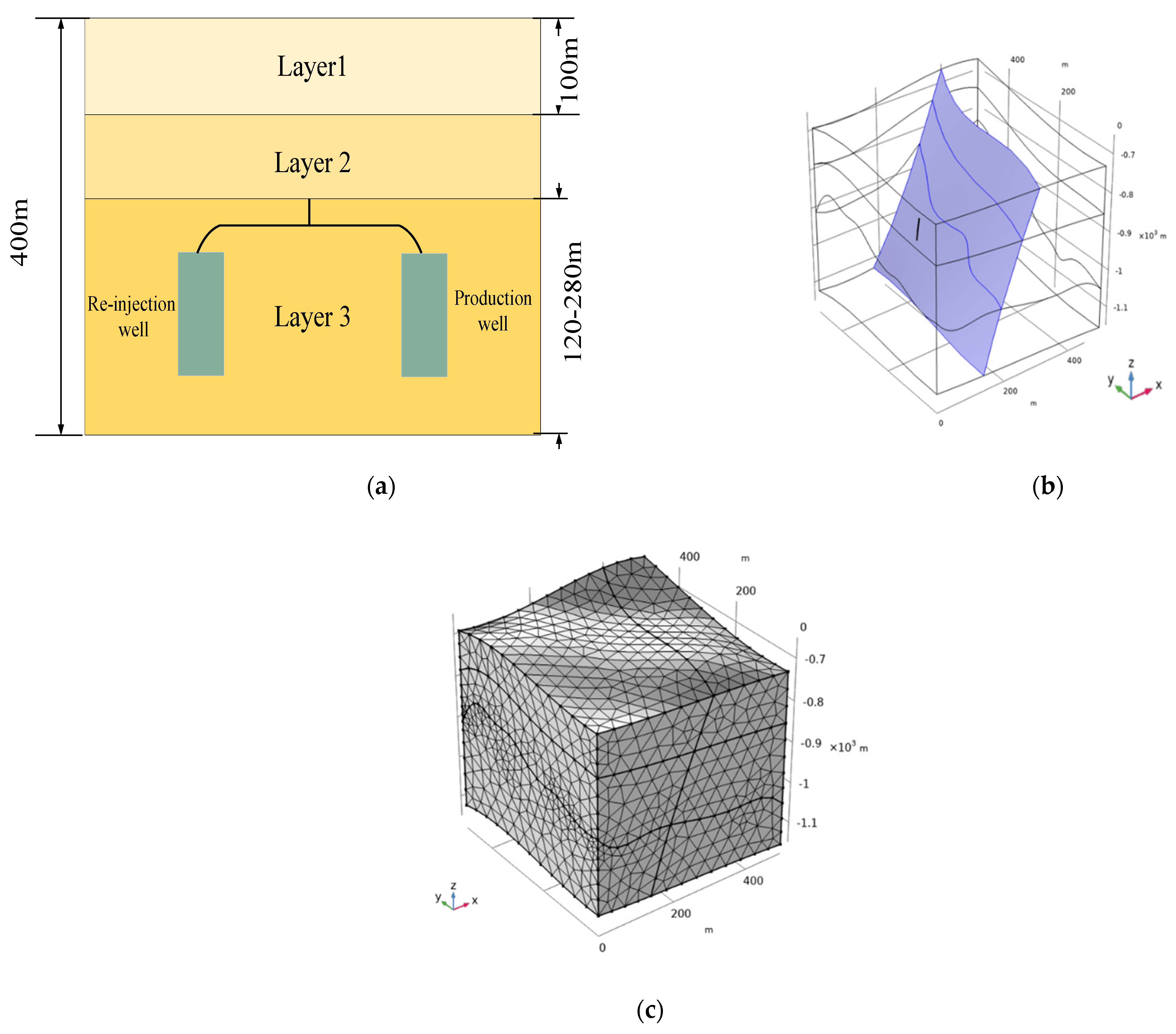
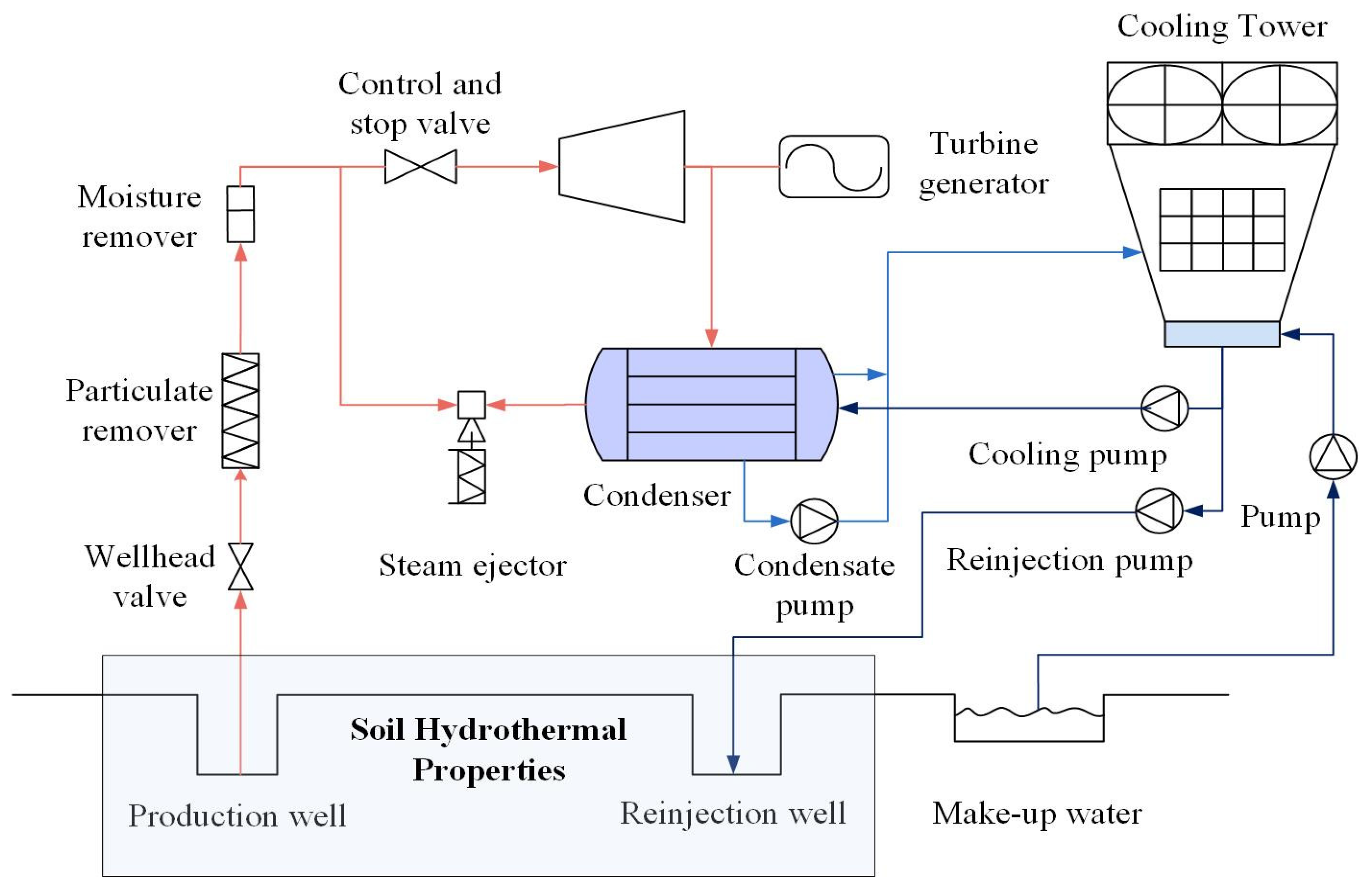

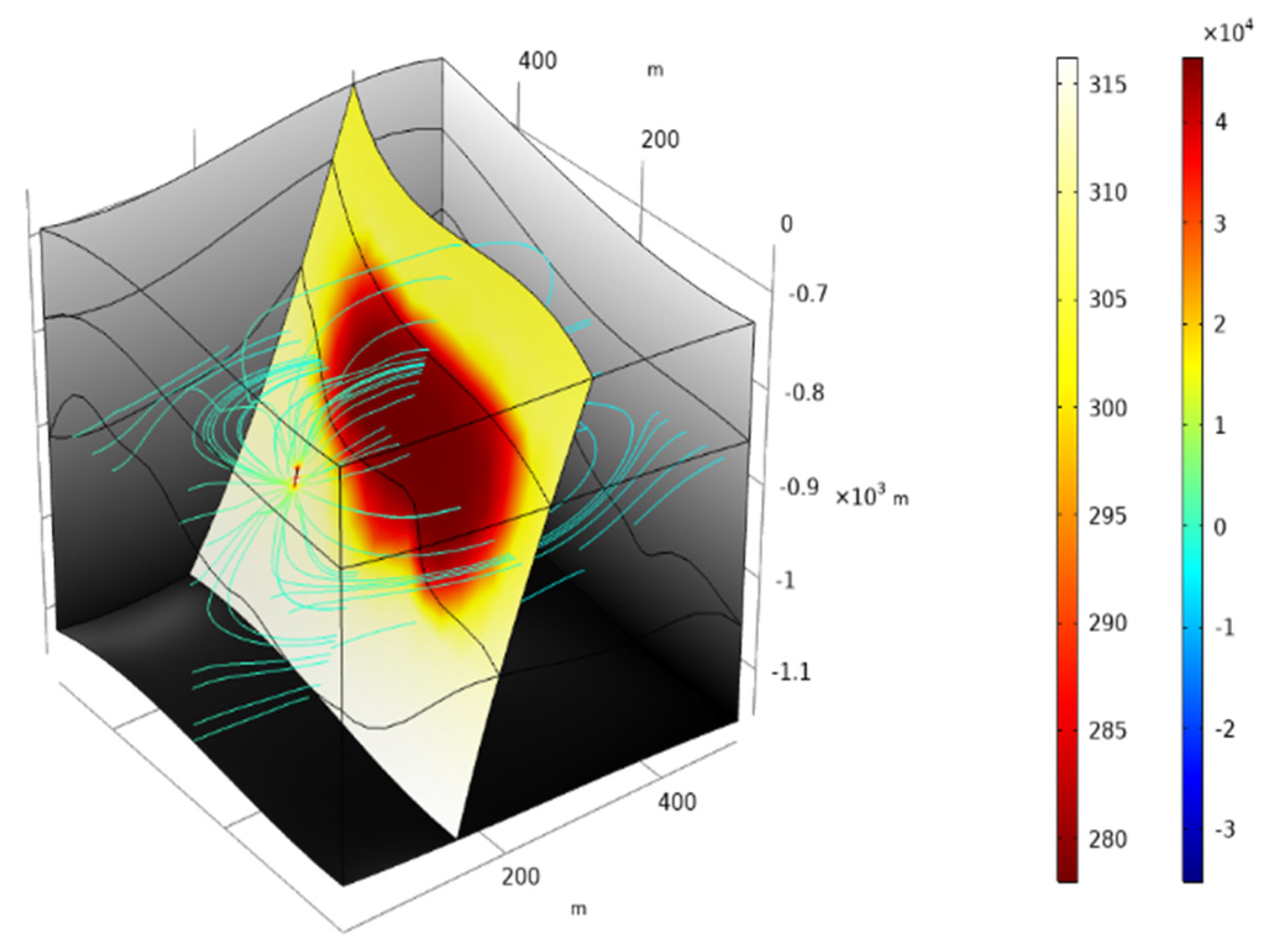
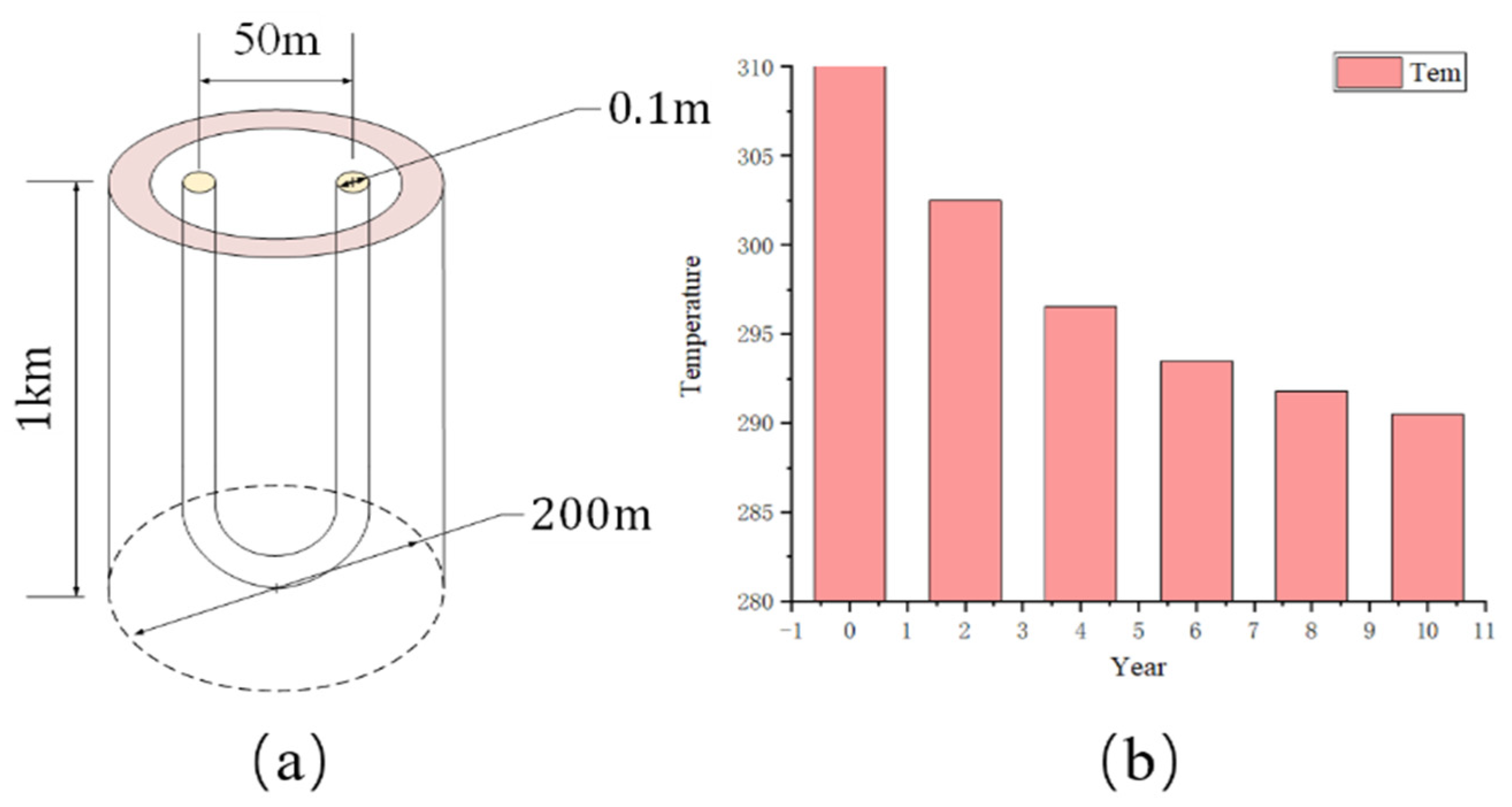
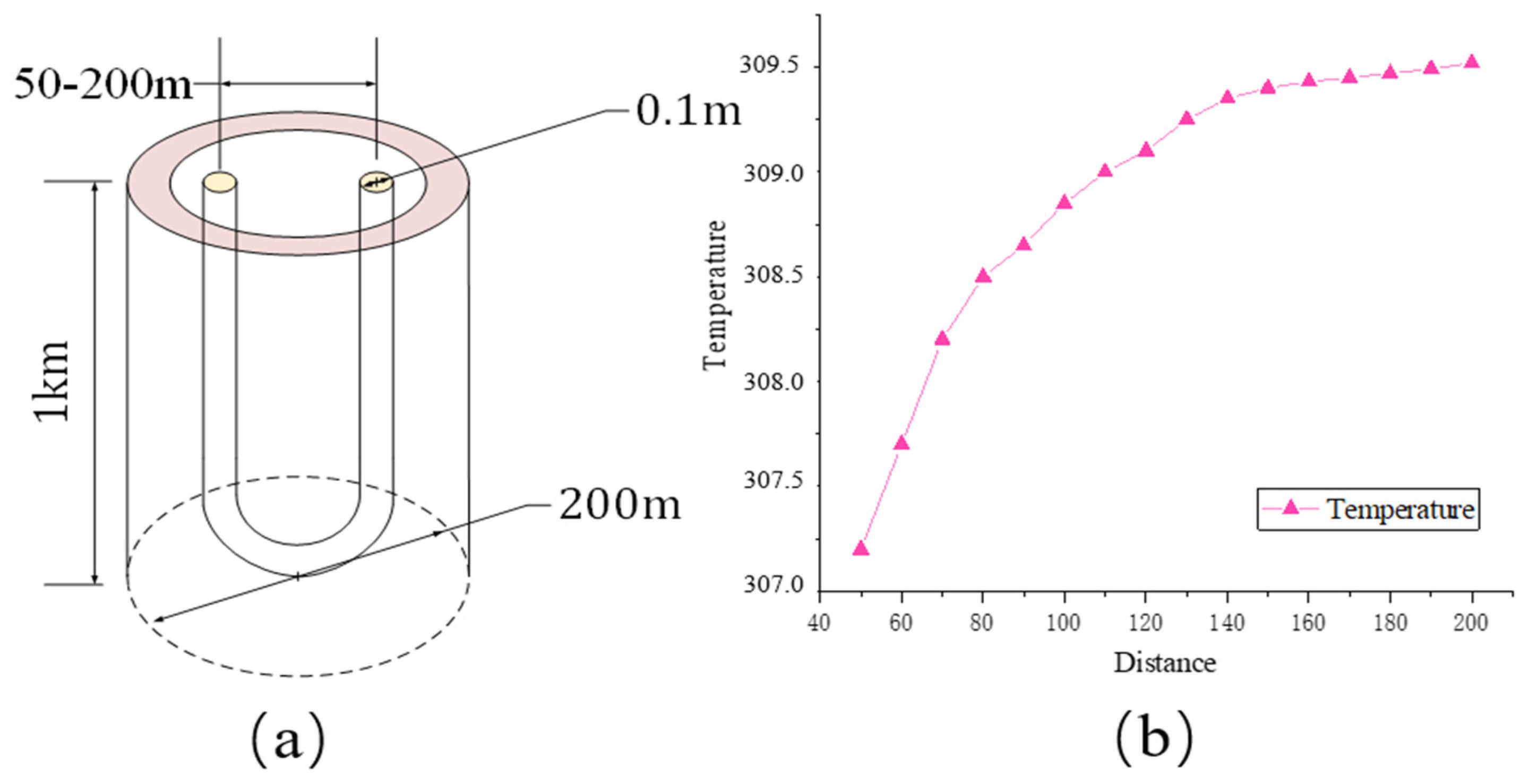
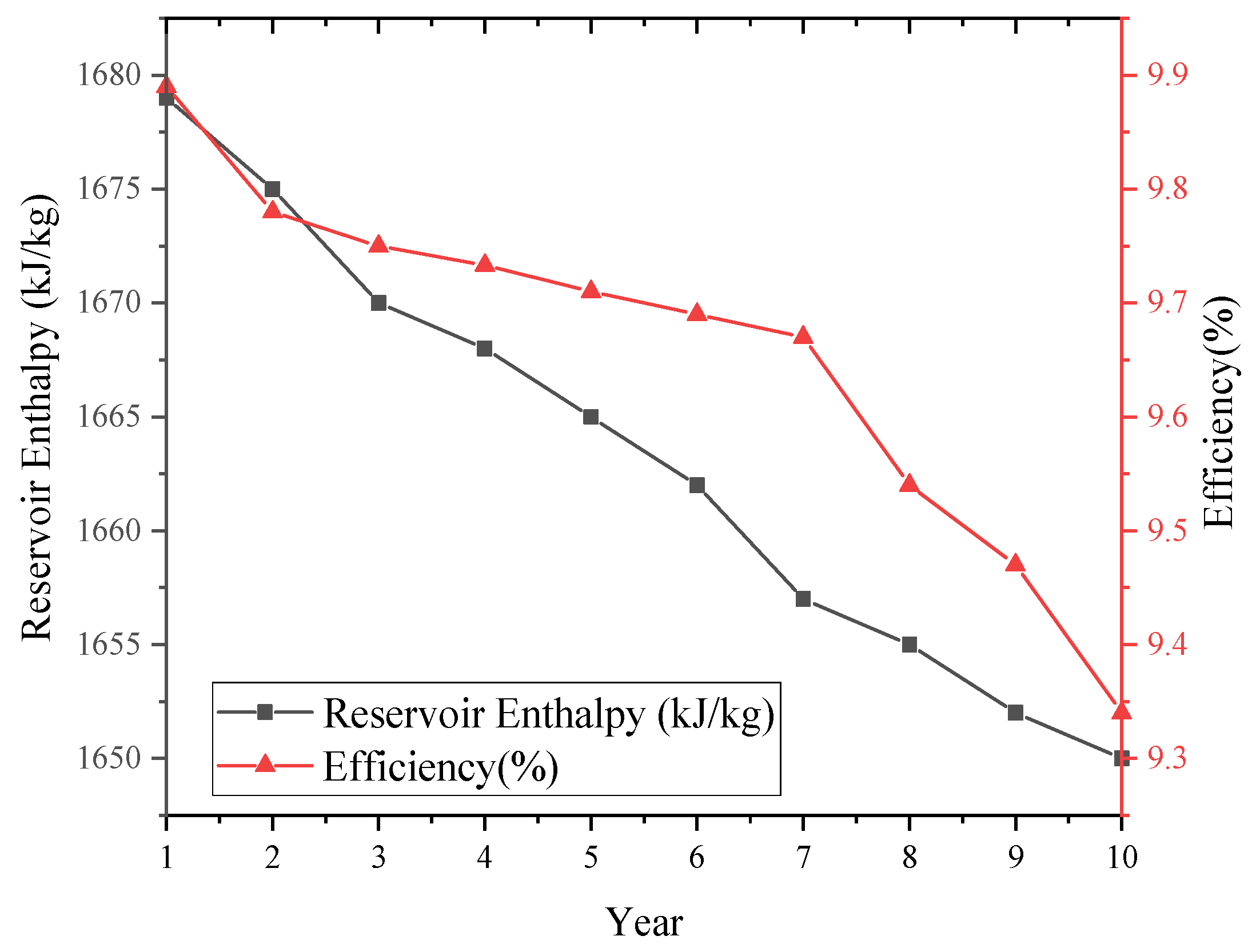
| Geothermal Conditions | Hydraulic Parameters | Geo-Model Settings | |||
|---|---|---|---|---|---|
| Geothermal gradient (K/m) | −0.03 | Pumping rate (L/s) | 190 | Time (year) | 10 |
| Surface temperature (K) | 283 | Fracture thickness (m) | 0.002 | Fracture roughness | 1.6 |
| Injection temperature (K) | 278 | Pumping rate (m3/s) | 0.12 | Borehole radius (m) | 1 |
| Water temperature (K) | 280 | Hydraulic gradient (mm/m) | 0~10 | Maximum step (day) | 0.5 |
| Layer | Top Layer | Middle Layer | Bottom Layer |
|---|---|---|---|
| Porosity | 0.1 | 0.4 | 0.3 |
| Permeability (m2) | 1 × 10−10 | 1 × 10−6 | 1 × 10−7 |
| Thermal conductivity W/(m·K) | 2 | 3 | 3.5 |
| Heat capacity J/(kg·K) | 900 | 850 | 850 |
| Density (kg/m3) | 1300 | 1900 | 2300 |
| Year | Power (kW) | Year | Power (kW) |
|---|---|---|---|
| 1 | 234.95 | 6 | 224.35 |
| 2 | 232.56 | 7 | 222.84 |
| 3 | 229.32 | 8 | 221.25 |
| 4 | 226.71 | 9 | 220.80 |
| 5 | 225.54 | 10 | 219.66 |
Publisher’s Note: MDPI stays neutral with regard to jurisdictional claims in published maps and institutional affiliations. |
© 2022 by the authors. Licensee MDPI, Basel, Switzerland. This article is an open access article distributed under the terms and conditions of the Creative Commons Attribution (CC BY) license (https://creativecommons.org/licenses/by/4.0/).
Share and Cite
Liu, Z.; Hou, G.; Song, Y.; Taherian, H.; Qi, S. The Impact of Soil Hydrothermal Properties on Geothermal Power Generation (GPG): Modeling and Analysis. Energies 2022, 15, 448. https://doi.org/10.3390/en15020448
Liu Z, Hou G, Song Y, Taherian H, Qi S. The Impact of Soil Hydrothermal Properties on Geothermal Power Generation (GPG): Modeling and Analysis. Energies. 2022; 15(2):448. https://doi.org/10.3390/en15020448
Chicago/Turabian StyleLiu, Zhengguang, Gaoyang Hou, Ying Song, Hessam Taherian, and Shuaiwei Qi. 2022. "The Impact of Soil Hydrothermal Properties on Geothermal Power Generation (GPG): Modeling and Analysis" Energies 15, no. 2: 448. https://doi.org/10.3390/en15020448
APA StyleLiu, Z., Hou, G., Song, Y., Taherian, H., & Qi, S. (2022). The Impact of Soil Hydrothermal Properties on Geothermal Power Generation (GPG): Modeling and Analysis. Energies, 15(2), 448. https://doi.org/10.3390/en15020448







